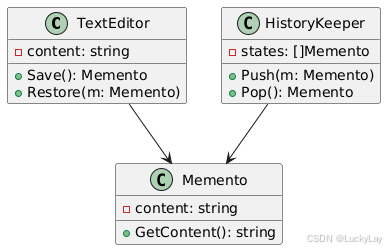Golang学习笔记_42——迭代器模式
Golang学习笔记_43——责任链模式
Golang学习笔记_44——命令模式
文章目录
一、核心概念
1. 定义
备忘录模式是一种行为型设计模式,通过在不破坏对象封装性的前提下捕获和存储对象内部状态,实现状态的可追溯恢复机制。其核心特点包括:
• 状态封装:将对象状态隔离在专用备忘录对象中
• 历史回溯:支持任意时间点的状态版本恢复
• 权限隔离:状态存储与恢复操作限定在特定对象间
2. 解决的问题
• 状态不可逆:缺乏标准化的撤销/恢复机制
• 数据暴露风险:直接访问对象内部状态破坏封装性
• 版本管理复杂:多版本状态存储与检索困难
3. 核心角色
| 角色 | 作用 |
|---|---|
| Originator | 创建并管理备忘录的生命周期,维护内部状态 |
| Memento | 存储Originator内部状态的安全容器 |
| Caretaker | 备忘录的存储管理者,维护历史状态记录栈 |
4. 类图
@startuml
class Originator {
- state: string
+ CreateMemento(): Memento
+ Restore(m: Memento)
}
class Memento {
- state: string
+ GetState(): string
+ SetState(s: string)
}
class Caretaker {
- history: []Memento
+ Save(m: Memento)
+ Retrieve(index int): Memento
}
Originator --> Memento
Caretaker --> Memento
note right of Originator::CreateMemento
创建包含当前状态的备忘录
仅Originator可访问完整数据
end note
@enduml
二、特点分析
优点
- 封装保护:严格限制状态访问权限
- 简化恢复:标准化状态回滚操作流程
- 版本控制:支持多时间点状态快照管理
缺点
- 内存消耗:大对象频繁快照导致资源占用
- 性能损耗:深拷贝复杂对象时效率下降
- 版本冲突:多版本管理可能引发状态不一致
三、适用场景
1. 文档编辑器
type EditorMemento struct {
content string
}
type TextEditor struct {
content string
}
func (e *TextEditor) Save() *EditorMemento {
return &EditorMemento{content: e.content}
}
func (e *TextEditor) Restore(m *EditorMemento) {
e.content = m.content
}
2. 游戏存档系统
type GameSave struct {
level int
weapons []string
}
type PlayerState struct {
current *GameSave
}
func (p *PlayerState) QuickSave() *GameSave {
return &GameSave{
level: p.current.level,
weapons: append([]string{}, p.current.weapons...),
}
}
3. 配置管理系统
type ConfigSnapshot struct {
version string
config map[string]interface{}
}
func RollbackConfig(snapshots []*ConfigSnapshot, targetVer string) error {
// 实现版本检索与配置回滚
}
四、Go语言实现示例
完整实现代码
package memento_demo
import "fmt"
// Memento 备忘录
type EditorMemento struct {
content string
}
func (m *EditorMemento) Content() string {
return m.content
}
// Originator 原发器
type TextEditor struct {
content string
}
func (e *TextEditor) Write(input string) {
e.content += input
}
func (e *TextEditor) Save() *EditorMemento {
return &EditorMemento{content: e.content}
}
func (e *TextEditor) Restore(m *EditorMemento) {
e.content = m.Content()
}
// Caretaker 管理者
type HistoryKeeper struct {
saves []*EditorMemento
}
func (h *HistoryKeeper) Push(m *EditorMemento) {
h.saves = append(h.saves, m)
}
func (h *HistoryKeeper) Pop() *EditorMemento {
if len(h.saves) == 0 {
return nil
}
last := h.saves[len(h.saves)-1]
h.saves = h.saves[:len(h.saves)-1]
return last
}
// 客户端使用示例
func ExampleUsage() {
editor := &TextEditor{}
history := &HistoryKeeper{}
// 编辑操作
editor.Write("Hello")
history.Push(editor.Save())
editor.Write(" World")
fmt.Println("Current:", editor.content)
// 撤销操作
if m := history.Pop(); m != nil {
editor.Restore(m)
}
fmt.Println("After Undo:", editor.content)
}
执行结果
=== RUN TestExampleUsage
Current: Hello World
After Undo: Hello
--- PASS: TestExampleUsage (0.00s)
PASS
五、高级应用
1. 增量快照系统
type DeltaMemento struct {
timestamp time.Time
delta []byte
}
func CreateDeltaSnapshot(prev, current *DocumentState) *DeltaMemento {
// 计算差异生成增量快照
}
2. 分布式状态同步
type StateSyncService struct {
snapshots map[string]*NodeState
}
func (s *StateSyncService) RollbackCluster(targetVer int) {
// 集群级状态回滚实现
}
六、与其他模式对比
| 模式 | 核心区别 | 典型应用场景 |
|---|---|---|
| 命令模式 | 操作封装 vs 状态存储 | 事务回滚系统 |
| 原型模式 | 对象克隆 vs 状态保存 | 复杂对象复制 |
| 状态模式 | 状态转移 vs 状态存档 | 工作流引擎 |
七、实现建议
- 状态序列化:使用JSON/gob实现快照持久化
func (m *Memento) Serialize() ([]byte, error) { return json.Marshal(m) } - 内存优化:采用写时复制技术减少内存占用
- 版本压缩:定期合并历史快照减少存储量
- 访问控制:严格限制Memento的字段可见性
八、典型应用
- IDE开发环境:代码修改历史追溯
- 区块链系统:区块状态回滚机制
- 机器学习:模型训练检查点
- CI/CD管道:部署失败快速回退
通过备忘录模式,可以构建具备完善历史管理能力的系统架构。在Go语言中,建议:
- 使用结构体嵌套实现宽接口/窄接口
- 结合channel实现异步快照存储
- 使用sync.Pool优化频繁创建的备忘录对象

